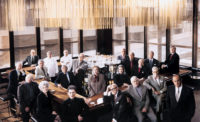Guggenheim Says Goodbye to Koolhaas, Hello to Hadid

Guggenheim Says Goodbye to Koolhaas, Hello to Hadid
Zaha Hadid's design for a proposed new branch of the Guggenheim in Vilnius, Lithuania, to be operated in partnership with Russia's State Hermitage Museum.
Images courtesy Guggenheim Foundation

Guggenheim Says Goodbye to Koolhaas, Hello to Hadid
A feasibility study, expected to finish in June, could determine whether or not the museum will get built.
Images courtesy Guggenheim Foundation

Guggenheim Says Goodbye to Koolhaas, Hello to Hadid
The building would be clad in aluminum panels.
Images courtesy Guggenheim Foundation

Guggenheim Says Goodbye to Koolhaas, Hello to Hadid
Hadid has described it as "a place where you can experiment with the idea of galleries, spatial complexity and movement."
Images courtesy Guggenheim Foundation




Post a comment to this article
Report Abusive Comment